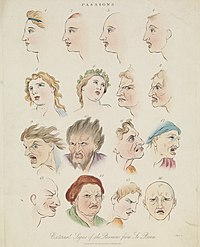
Photo from wikipedia
Research on emotion dynamics as indices of emotion functioning has become muddled by conceptual confusion, methodological heterogeneity, and seemingly conflicting results. One way to address this chaos is the study… Click to show full abstract
Research on emotion dynamics as indices of emotion functioning has become muddled by conceptual confusion, methodological heterogeneity, and seemingly conflicting results. One way to address this chaos is the study of profiles of emotion dynamics across 12 emotions and how they differ between 246 adolescents. The interpretation of these dynamic profiles was guided by auxiliary variables including age, personality, depressive symptoms, and social experiences. During 6 days, 246 adolescents (Mage = 14.20; 65% female) rated nine times daily the intensity of 12 emotions (cheerful, happy, energetic, joyful, content, relaxed, anxious, worried, irritable, insecure, down, and guilty) and their social experiences with family, friends, and classmates. Additional baseline measures included neuroticism, extraversion (Revised Junior Eysenck Personality Questionnaire Short Form), and depressive symptoms (Center for Epidemiological Studies Depression Scale). A three-mode principal component analysis (3MPCA Tucker3-based) model was estimated on the person-specific dynamic parameters of emotional intensity (mean), variability (standard deviation), instability (mean squared successive difference), and inertia (autocorrelation). The 3MPCA identified three emotion-mode components (positive affect, negative affect, and irritability) and three dynamic-mode components (emotional intensity, lability, and inertia). Five individual-mode components captured interactions between these modes, of which positive affect explained most variation in the data. These emotion dynamic profiles correlated differently with social experiences. Additional 3MPCA model structures based on imputed data (correcting missing autocorrelations) and affect scale composites (low- and high-arousal positive and negative affect) showed strong resemblance. The identified emotion dynamic profiles capture meaningful interpersonal differences in adolescents' emotional experiences and change. Future work should focus on irritability and positive affect as these were uniquely informative in adolescents' emotional experiences. (PsycInfo Database Record (c) 2022 APA, all rights reserved).
Journal Title: Emotion
Year Published: 2022
Link to full text (if available)
Share on Social Media: Sign Up to like & get
recommendations!